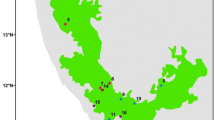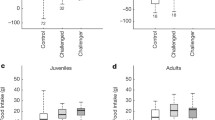Abstract
Correlations among female age, dominance, and reproduction were investigated for a 12-year period in free-ranging, provisioned Hanuman langurs (Presbytis entellus), living in one-male groups near Jodhpur in Rajasthan, India. Of 2940 displacement episodes, 27% occurred over natural food, 26% over provisioned food, 8% over grooming, 23% over position and shade, and 16% for other reasons. It was possible to reconstruct a displacement hierarchy that was linear and stable over short periods but fluctuated according to the age composition of the troop, resulting in an age inversed dominance structure. Females occupied top ranks as soon as they experienced menarche (around 2.4 years of age) and gradually declined thereafter, with postmenopausal females (≥30 years) being the lowest ranking individuals. Old females tended to be peripheral, while young females were highly social and active. Fertility peaked at about 7 years and gradually decreased thereafter, but infant mortality was much higher in young females than in old ones. During years when females gave birth, their ranks, especially those of old females, were higher than the average expectation for their age class, which suggests that females compete more vigorously if they have an infant. Reproductive success (i.e., infant survival to ≥2 years) declined significantly from high-over middle-to low-ranking females but did not differ for the three age classes investigated, because the higher fecundity of young females was balanced by better rearing success of older females. These results are discussed in light of the controversy over whether the langur social system is strongly influenced by kin selection (Hrdy and Hrdy, 1976; Dolhinow et al., 1979).
Similar content being viewed by others
References
Alexander, B. K., and Bowers, J. M. (1969). Social organization of a troop of Japanese monkeys in a two acre enclosure.Folia Primatol. 10: 230–242.
Altmann, J. (1974). Observational study of behavior: sampling methods.Behaviour 49: 227–267.
Altmann, J., Hausfater, G., and Altmann, S. A. (1988). Determinants of reproductive success in savannah baboons,Papio cynocephalus. In Clutton-Brock, T. H. (ed.),Reproductive Success: Studies of Individual Variation in Contrasting Breeding Systems, University of Chicago Press, Chicago and London, pp. 403–418.
Bernstein, I. S. (1969). Stability of the status hierarchy in a pigtail monkey group (Macaca nemestrina).Anim. Behav. 17: 452–458.
Bingham, L. R., and Hahn, T. C. (1974). Observations on the birth of a lowland gorilla,Gorilla gorilla gorilla in captivity.Int. Zoo. Yb. 14: 113–115.
Bishop, N. (1975)Social Behavior of Langur Monkeys (Presbytis entellus) in a High Altitude Environment, Ph.D. thesis, University of California, Berkeley.
Boggess, J. E. (1976).Social Behavior of the Himalayan Langur (Presbytis entellus) in Eastern Nepal, Ph.D. thesis, University of California, Berkeley.
Borries, C. (1988). Patterns of grandmaternal behaviour in free-ranging Hanuman langurs (Presbytis entellus).Hum. Evol. 3: 239–260.
Borries, C. (1989a).Konkurrenz unter freilebenden Langurenweibchen (Presbytis entellus), Ph.D. thesis, Georg-August-Universität, Göttingen.
Borries, C. (1989b). Mothers and adult daughters—on kinship in free-ranging Hanuman langurs (Presbytis entellus).Primate Rep. 25: 10.
Bulger, J., and Hamilton, W. J., III (1987). Rank and density correlates of inclusive fitness measures in a natural chacma baboon (Papio ursinus) troop.Int. J. Primatol. 8: 635–650.
Clutton-Brock, T. H., Albon, S. D., Gibson, R. M., and Guinness, F. E. (1979). The logical stage: Adaptive aspects of fighting in red deer.Anim. Behav. 27: 211–225.
Dittus, W. P. J. (1979). The evolution of behaviors regulating density and age-specific sex ratios in a primate population.Behaviour 69: 266–302.
Dolhinow, P., McKenna, J. J., and Vonder Haar Laws, J. (1979). Rank and reproduction among female langur monkeys: Aging and improvement (They're not just getting older, they're getting better).Aggr. Behav. 5: 19–30.
Drickamer, L. C. (1974). A ten-year summary of reproductive data for free rangingMacaca mulatta.Folia Primatol. 21: 61–80.
Dubois, J. A. (1989). The effects of parturition on patas females' social interaction.Am. J. Primatol. 18: 142.
Dunbar, R. I. M. (1984).Reproductive Decisions: An Economic Analysis of Gelada Baboon Social Strategies, Princeton University Press, Princeton, N.J.
Dunbar, R. I. M. (1989). Reproductive strategies of female gelada baboons. In Rasa, A. E., Vogel, C., and Voland, E. (eds.),The Sociobiology of Sexual and Reproductive Strategies, Chapman and Hall, London, pp. 74–92.
Fairbanks, L. A., and McGuire, M. T. (1984). Determinants of fecundity and reproductive success in captive vervet monkeys.Am. J. Primatol. 7: 27–38.
Fedigan, L. M. (1983). Dominance and reproductive success in primates.Yb. Phys. Anthropol. 26: 91–129.
Fisher, R. A. (1958).The Genetical Theory of Natural Selection, Dover, New York.
Geist, V. (1971).Mountain Sheep, University of Chicago Press, Chicago.
Glander, K. E. (1980). Reproduction and population growth in free-ranging mantled howling monkeys.Am. J. Phys. Anthropol. 53: 23–36.
Goodall, J. (1986)The Chimpanzees of Gombe. Patterns of Behavior, Belknap Press, Cambridge, Mass.
Gray, J. P. (1985).Primate Sociobiology, Hraf Press, New Haven, Conn.
Hamilton, W. D. (1964). The genetical evolution of social behavior, parts 1 and 2.J. Theor. Biol. 7: 1–51.
Harcourt, A. H. (1987). Dominance and fertility among female primates.J. Zool. 213: 471–487.
Harley, D. (1983).Reproduction in Captive Female Langur Monkeys (Presbytis entellus), Ph.D. thesis, University of California, Berkeley.
Hausfater, G. (1975) Dominance and reproduction in baboon (Papio cynocephalus).Contr. Primatol. 7, Karger, Basel.
Hrdy, S. B. (1977)The Langurs of Abu. Female and Male Strategies of Reproduction. Harvard University Press, Cambridge, Mass.
Hrdy, S. B., and Hrdy, D. B. (1976). Hierarchical relations among female Hanuman langurs (Primates:Colobinae, Presbytis entellus).Science 193: 913–915.
Jay, P. C. (1963).The Social Behavior of the Langur Monkey, Ph.D. thesis, University of Chicago, Chicago.
Johnson, R. L. (1989). Live birthrates in two free-ranging rhesus breeding colonies in the Florida keys.Primates 30: 433–437.
Jones, C. B. (1980). The functions of status in the mantled howler monkey,Albouatta palliata Gray: Intraspecific competition for group membership in a folivorous neotropical primate.Primates 21: 389–405.
Jones, C. B. (1983). Social organization of captive black howler monkeys (Alouatta caraya): “Social competition” and the use of non-damaging behavior.Primates 24: 25–39.
Lee, P. C. (1987). Nutrition, fertility, and maternal investment in primates.J. Zool. 213: 409–422.
Loy, J. (1975). The descent of dominance inMacaca: Insights into the structure of human societies. In Tuttle, R. H. (ed.)Socioecology and Psychology of Primates, Mouton, Paris, pp. 153–180.
McKenna, J. J. (1975).An Analysis of the Social Roles and Behaviors of Seventeen Captive Hanuman Langurs (Presbytis entellus), Ph.D. thesis, University of Oregon, Eugene.
Meikle, D. B., Tilford, B. L., and Vessey, S. H. (1984). Dominance rank, secondary sex ratio, and reproduction of offspring in polygynous primates.Am. Nat. 124: 173–188.
Mohnot, S. M. (1974).Ecology and Behaviour of the Common Indian Langur, Presbytis entellus Dufrèsene, Ph.D. thesis, University of Jodhpur Jodhpur.
Nowell, L. H., and Heidrich, A. G. (1978). Factors affecting dominance relationships in adult female baboons. In Chivers, D. J., and Herbert, J. (eds.),Recent Advances in Primatology, Vol. 1. Behaviour, Academic Press, London, pp. 63–66.
Paul, A. (1984).Zur Sozialstruktur und Sozialisation semifreilebender Berberaffen (Macaca sylvanus L. 1758). Ph.D. thesis, Christian-Albrechts-Universität, Kiel.
Paul, A., and Küster, J. (1988). Life-history patterns of Barbary macaques (Macaca sylvanus) at Affenberg Salem. In Fa, J. E., and Southwick, C. H., (eds.),Ecology and Behavior of Food-Enhanced Primate Groups, Alan R. Liss, New York, pp. 199–228.
Post, D., Hausfater, G., and McCuskey, S. (1980). Feeding behavior of yellow baboons (Papio cynocephalus): Relationship to age, gender, and dominance rank.Folia Primatol. 34: 170–195.
Ripley, S. (1965).The Ecology and Social Behaviors of the Ceylon Gray Langur, Presbytis entellus thersites, Ph.D. thesis, University of California, Berkeley.
Robinson, J. G. (1982). Intrasexual competition and mate choice in primates.Am. J. Primatol. Suppl. 1: 131–144.
Sade, D. S. (1967). Determinants of dominance in a group of free-ranging rhesus monkeys. In Altmann, S. A. (ed.),Social Communication Among Primates, University of Chicago Press, Chicago, pp. 99–114.
Schjelderup-Ebbe, T. (1992). Beiträge zur Sozialpsychologie des Haushuhns.Z. Psychol. 88: 225–252.
Seger, J. (1977). A numerical method for estimating coefficients of relationship in a langur troop. In Hrdy, S. B.,The Langurs of Abu-Female and Male Strategies of Reproduction, Harvard University Press, Cambridge, Mass, pp. 317–326.
Seyfarth, R. M. (1976). Social relationships among adult female baboons.Anim. Behav. 24: 917–938.
Silk, J. B. (1987). Social behavior in evolutionary perspective. In Smuts, B. B., Cheney, D. L., Seyfarth, R. M., Wrangham, R. W., and Struhsaker, T. T. (eds.),Primate Societies, University of Chicago Press, Chicago, 318–329.
Silk, J. B., Clark-Wheatley, C. B., Rodman, P. S., and Samuels, A. (1981). Differential reproductive success and facultative adjustment of sex ratios among captive female bonnet macaques (Maccaca radiata).Anim. Behav., 29: 1106–1120.
Small, M. F. (1981). Body fat, rank, and nutritional status in a captive group of rhesus macaques.Int. J. Primatol. 2: 91–96.
Sommer, V. (1985).Weibliche und männliche Reproduktionsstrategien der Hanuman-Languren (Presbytis entellus) von Jodhpur, Rajasthan/Indien, Ph.D. thesis, Georg-August-Universität, Göttingen.
Sommer, V. (1987). Infanticide among free-ranging langurs (Presbytis entellus) at Jodhpur (Rajasthan/India): Recent observations and a reconsideration of hypotheses.Primates 28: 163–197.
Sommer, V. (1989). Infant mistreatment in langur monkeys-sociobiology tackled from the wrong end? In Rasa, A. E., Vogel, C., and Voland, E. (eds.),The Sociobiology of Sexual and Reproductive Strategies, Chapman and Hall, London, pp. 110–127.
Sommer, V., and Rajpurohit, L. S. (1989). Male reproductive success in harem troops of Hanuman langurs (Presbytis entellus).Int. J. Primatol. 10: 293–317.
Sommer, V., Srivastava, A., and Borries, C. (1990). Cycles, sexuality and conception in free-ranging langurs (Presbytis entellus) (submitted for publication).
Srivastava, A. (1989).Feeding Ecology and Behaviour of Hanuman Langur, Presbytis entellus, Ph.D. thesis, University of Jodhpur, Lodhpur.
Strum, S. C., and Western, J. D. (1982). Variations in fecundity with age and environment in olive baboons (Papio anubis).Am. J. Primatol. 3: 61–76.
Sugiyama, Y. (1967). Social organization of Hanuman langurs. In Altmann, S. A. (ed.),Social Communication Among Primates, University of Chicago Press, Chicago, pp. 221–236.
Sugiyama, Y. (1971). Characteristics of the social life of bonnet macaques (Macaca radiata).Primates 12: 247–266.
Sugiyama, Y., and Ohsawa, H. (1982). Population dynamics of Japanese monkeys with special reference to the effect of artificial feeding.Folia Primatol. 39: 238–263.
Van Noordwijk, M. A., and Van Schaik, C. P. (1987). Competition among female long-tailed macaques,Macaca fascicularis.Anim. Behav. 35: 577–589.
Vogel, C. (1976). Ökologie, Lebensweise und Sozialverhalten der grauen Languren in verschiedenen Biotopen Indiens, Parey, Berlin.
Waser, P. M. (1978). Postreproductive survival and behaviors in a free-ranging female mangabey (Cercocebus albigena).Folia Primatol. 29: 142–160.
Weisbard, C., and Goy, R. W. (1976). Effect of parturition and group composition on competitive drinking order in stumptail macaques (Macaca arctoides).Folia Primatol. 25: 95–121.
Whitten, P. L. (1983). Diet and dominance among female vervet monkeys (Cercopithecus aethiops).Am. J. Primatol. 5: 139–159.
Whitten, P. L. (1984). Competition among female vervet monkeys. In Small, M. F. (ed.),Female Primates: Studies by Woman Primatologist, Alan R. Liss, New York, pp. 127–140.
Winkler, P. (1981).Zur Öko-Ethologie freilebender Hanuman-Languren (Presbytis entellus entellus Dufresne, 1797) in Jodhpur (Rajasthan), Indien, Ph.D. thesis, georg-August-Universität, Göttingen.
Winkler, P., Loch, H., and Vogel, C. (1984). Life history of Hanuman langurs (Presbytis entellus)—reproductive parameters, infant mortality, and troop development.Folia Primatol. 43: 1–23.
Yoshiba, K. (1968). Local and intertroop variability in ecology and social behavior of common Indian langurs. In Jay, P. (ed.),Primates: Studies in Adaptation and Variability, Holt, Rinehart and Winston, New York, pp. 217–242.
Author information
Authors and Affiliations
Rights and permissions
About this article
Cite this article
Borries, C., Sommer, V. & Srivastava, A. Dominance, age, and reproductive success in free-ranging female hanuman langurs (Presbytis entellus). International Journal of Primatology 12, 231–257 (1991). https://doi.org/10.1007/BF02547586
Received:
Revised:
Issue Date:
DOI: https://doi.org/10.1007/BF02547586




